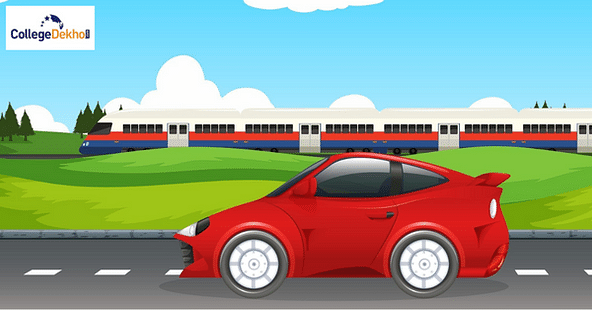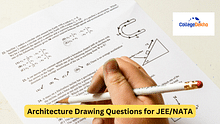Motion in a Straight Line comprises of an important chapter in Physics for class 12th. Read here to learn all about Motion in a Straight Line.
- Motion in a Straight Line
- Frame of Reference
- Motion in a Straight Line
- Position, Path Length and Displacement
- Average Velocity and Average Speed
- Instantaneous Velocity and Speed
- Kinematic Equations for Uniformly Accelerated Motion
- Second Equation of Motion
- Important Formulas
- Examples of Questions Asked in the Exam
- Motion in a Straight Line: Previous Year’s Question Papers

Motion in a Straight Line
What is motion? Every object in our universe moves. Your table, your floor, your house walls, all of these are moving continuously. Some of the objects might move by very small distances and very slowly but the motion keeps happening. Even if you don't move and sit still, the movement still happens as our Earth is moving around the Sun and the mighty sun is moving around the galaxy. So we can describe motion through the following phrase:
“An object is said to be in motion if its position changes with time”.
But what is motion in a straight line? Motion in a straight line refers to the linear movement of the objects. This means in this motion, only one dimension is used for movement. Let us understand the concept of motion in a straight line in detail section by section.
Frame of Reference
The frame of reference refers to the complex set of attitudes and assumptions which is used with the purpose of filtering out the perceptions to create meaning. One of the most common examples for frame of reference is a rectangular coordinate system of three mutually perpendicular axes as X, Y, and Z. The point at which these 3 axes intersect is known as the Origin and is considered as the reference point. The coordinates x,y, and z demonstrate the position of the object with respect to the coordinate system. If we align this system with a clock, it will be considered as the frame of reference.
In context of motion, there are two major types of frame of reference:
- Inertial Frame of Reference
- Non-Inertial Frame of Reference
Inertial Frame of Reference
Inertial Frame of Reference refers to the frame of reference which moves with constant velocity with respect to an inertial frame.
Non-Inertial Frame of Reference
Inertial Frame of Reference refers to the frame of reference in which the object goes under any accelerating force such as mechanical acceleration or gravity.
Also Read:
Motion in a Straight Line
Motion in a straight line is also termed as a one dimensional motion. A motion is termed as one dimensional motion if only one out of the 3 coordinates demonstrating the position of the object changes with respect to the time. It follows Newton's first law of motion that states that if a body is at rest or moving at a constant speed in a straight line, it will remain at rest or keep moving in a straight line at constant speed unless it is acted upon by a force. Some examples of motion in a straight line include motion of a block in a straight line motion of a train along a straight track, a man walking on a level and narrow road and object falling under gravity etc. It is also known as linear motion.
Types of Linear Motion
There are majorly two types of linear motion:
- Uniform linear motion having a constant velocity or zero acceleration
- Non-Uniform linear motion having variable velocity or non-zero acceleration
Uniform Linear Motion in a Straight Line
An object is said to have a uniform linear motion in a straight line if it moves in a straight line and covers an equal distance in equal interval of time. That means if the rate of change of an object’s velocity is constant, then it has a uniform motion.
Example
For example, if a ball is thrown at a speed of 60 kmph, then it will be moving with a velocity of 1 km per minute. This acceleration of the ball will be uniform.
Non- Uniform Linear Motion in a Straight Line
An object is said to have a non-uniform linear motion in a straight line if it moves with an unequal amount of velocity in equal intervals of time. In simple words, in a non- uniform linear motion, the rate of change of the object’s velocity is different at different points of time during motion.
Example
For example, if a box is dragged from a path. It might cover 100 meters at first and then 200 meters at second. Hence, the acceleration of the box will be non-uniform.
Position, Path Length and Displacement
Position
The motion of an object is described using the position of the object. For example, if you moved from point A to B, your initial position was A from which you moved to B after some time. So, how is your initial position represented? It can be represented using a reference point and three mutually perpendicular axes: X, Y, and Z. The origin is known as the reference point where all three axes intersect. So A point will be taken as the origin with coordinates (0, 0, 0) and B point will be represented as the set of coordinates on (X, Y, Z). Since the motion refers to change in position along with the time, we will include a clock in this system which will constitute a frame of reference.
Path Length
Path length refers to the length of the path covered by an object while moving from the initial point to the final point.
Displacement
Displacement refers to the shortest path as a straight line between the initial point and the final point. It is a vector quantity as it has both magnitude & direction.
If A is the initial position of an object and B is the final point, then the displacement will be calculated as:
D = A - B
Where D is a variable referred to as displacement.
Average Velocity and Average Speed
Average Velocity
Average velocity for an object refers to the displacement of the object with respect to the initial position divided by the total time taken to cover the distance. In simple words, it represents the rate at which an object is displaced with time. SI unit of velocity is meters per second.
Average velocity can be calculated by the formula V = D/t,
Where V equals the average velocity, D equals total displacement and t equals total time.
Average Speed
The average speed for an object refers to the total distance covered by that object divided by the total time taken to cover the distance. The average speed for any object also represents the average rate at which it will cover a specific distance. For example, with a 25 km per hour speed, the position of the object will change with a rate of 25 km each hour. SI unit of speed is meters per second.
Average speed can be calculated by the formula S = d/t,
Where, S equals the average speed, d equals total distance and t equals total time.
Instantaneous Velocity and Speed
Instantaneous Velocity
Instantaneous velocity refers to the velocity of an object at any instant of time. If the velocity is non- constant, then it will be different from the average velocity. While at the same time, the instantaneous velocity and average velocity of an object will be the same for a time period.
Formula for Instantaneous Velocity:
In this formula, dS is the Displacement vector.
Instantaneous Speed
The speed of an object at any given instant is known as instantaneous speed. It is calculated by finding out the average Speed over a very short Distance and Time. Instantaneous speed is also equal to the speed of an object at any interval of time. It is measured in meters per second (m/ s).
Formula for Instantaneous Speed:
Instantaneous Speed = limit as a change in Time approaches zero (change in positron/ change in Time)
In this formula, x is the total distance moved by the object.
Kinematic Equations for Uniformly Accelerated Motion
If the initial velocity of an object is ‘u’ and after ‘t’ time, its velocity changes to ‘v’, and if the uniform acceleration is ‘a’ and the distance covered by the object in time (t) is s, then the following Kinematic Equations for Uniformly Accelerated Motion can be obtained:
First Equation of Motion
Assume that an object is moving with a uniform acceleration, where
u = initial velocity of the object
v = final velocity of object
a = uniform acceleration
If the object reaches a point B in a time (t), then from the graph:
Second Equation of Motion
Suppose an object starts with an initial velocity of ‘u’ and is moving with a uniform acceleration of ‘a’. Then the distance covered by the object at any instant of time t can be calculated by calculating the area of trapezium ABDOE. In the below formula, in the given time ‘t’, the displacement covered by the moving object ‘s’ is given by the area of a trapezium, ABDOE:
Velocity time graph of a uniformly accelerated motion
The above figure shows the velocity-time graph of a uniformly accelerated motion. It is a straight line graph which inclines towards the time axis. As per the graph, if an object has positive constant acceleration, then the slope will go in the upward direction. On the other hand, if an object has negative constant acceleration, then the slope will go in the downward direction.
Important Formulas
Some of the important formulas that you need to memorize for motion in a straight line are as follows:
Displacement | Δx = xf − xi |
|---|---|
Total displacement | Δx Total = ∑ Δ xi |
Instantaneous velocity | v(t) = dx(t) / dt |
Average velocity | V = Δx/ Δt = x2 − x1 / t2 − t1 |
Instantaneous speed | |v(t)| |
Average speed | S = Total distance/ Elapsed time |
Instantaneous acceleration | a(t) = dv(t) / dt |
Average acceleration | a = Δv / Δt = vf − x0 / tf − t0 |
Position from average velocity | x = x0 + v |
Velocity from acceleration | v = v0 + at (constant a) |
Examples of Questions Asked in the Exam
Given below are some of the examples of questions that are asked in the exam related to Motion in a Straight Line. The students can take these questions as a reference to prepare for the topic:
Q1. An automobile traveling with a speed of 60 Km/h can apply the brake to stop within a distance of 20 m If the car is going twice as fast i.e., 120 Km/h the stopping distance will be
- 60m
- 40m
- 20m
- 80m
Answer: D
Q2. A cart that is free to move in one dimension is moving in the positive direction and slowing down under the influence of a constant backward pull until the cart comes to a momentary stop and reverses direction. What are the signs of the cart’s velocity and acceleration during the moment it is stopped?
- velocity : 0 acceleration : +
- acceleration : 0 velocity : +
- velocity : 0 acceleration : –
Answer: C. Since the cart has stopped at the moment, the speed and velocity of the cart are zero. Hence the cart achieves negative velocity which means that it should be accelerating in the negative direction to raise velocity from zero to finite value in the negative direction.
Motion in a Straight Line: Previous Year’s Question Papers
The students can also refer to the following previous years questions to learn more about the type of questions asked in the exam:
Stay tuned to CollegeDekho for more Education News!

















Similar Articles
UP B.Ed JEE 2024 Hindi/ English: List of Important Topics & Weightage
Jharkhand B.Ed Entrance Exam 2024: Admit Card, Exam Date (April 21), Answer Key, Result
Jharkhand B.Ed Entrance Exam 2024 Section-Wise Preparation Tips
Jharkhand B.Ed Entrance Exam 2024 Syllabus and Section-Wise Weightage
How to Prepare for Jharkhand B.Ed Entrance Exam 2024?
NEP 2020: 3-Year vs 4-Year Bachelor’s Degree, 1-Year Master’s Course, Exit Option, Multidisciplinary Education